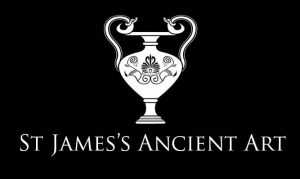Bronze or silver statuettes were popular across the Roman Empire, usually modelled in the shape of gods, goddesses and animals. Such statuettes could have been part of private households or placed in temples as votive offerings.
In the Roman religion, Lares were protective deities, who watched over, protected, and influenced what happened within the boundaries of their locations. Archaeological and literary evidence speaks to their significant role in Roman life, religion, and politics. While sometimes classified as household gods, Lares could preside over a number of different domains, such as roadways, seaways, agriculture, livestock, towns, cities, the state, and the military. The Lares would be named accordingly, for example, Lares Compitalicii were Lares of the local community and their statuettes could have been found in shrines at the major crossroads of their neighbourhood. The Lares Domestici or the Lares Familiares would look after the home and family, and were placed within the household shrine, among images of household’s penates, genius, and other favoured deities, found in traditional Roman homes. Within the Roman household, it was the responsibility of the the paterfamilias, the head of the household, to ensure that the household cult and the Lares were properly worshipped and attended to, which involved making offerings of wheat, honey-cakes, pigs, grapes, fruits, and wine.













